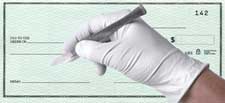
Has writing a check become so rote that you whiz through the process without actually thinking what you’re signing? You’re turning over hard-earned money, so take a moment to step into our laboratory, where we’re dissecting a paper check today. Scrub in, glove up, and learn about this payment option that’s still a top choice for many merchants today. So, let’s dig in. No anesthesia required.
Read more: Check Processing Services for Retailers: 4 Stand Out Tips
Contact Information
The first thing your eyeball should snag when it looks at a check is the contact information in the top-left corner. All checks will have the check holder’s name and address. Some checks take it further, with additional information such as a driver’s license number, phone number, and social security number. This is a personal option for the check holder. Some people include these details so they don’t have to write them when shopping. Others prefer not to, to protect certain identity details.
Running the Numbers
As your eyes slide across the top edge of the check, the next major piece of information you’ll see is the check number. Check books are printed sequentially, and when you can, you should write them sequentially as well. This is mostly to help you keep track when you balance your check books, as well as to know how many checks you have left in the book. There’s really only one time when a check number comes into play: Some merchants will not take “starter” checks – the first 50 you receive upon opening an account.
Flash back in time and read more: We Love the 80s: Checking Accounts Stay Solid for Three Decades
The String’s the Thing
Across the bottom of the check is the main meat, a long string of numbers and characters, but even this grouping gets dissected down. The first nine numbers in the string provide insight into your banking institution. This is the bank’s routing number, which appears as the same string on all checks written from that institution. So, if you have family or friends who bank at your bank, the first nine numbers on all of your checks will be the same.
It’s Just You
The next set of numbers is unique to you alone, and that’s your bank account identification. These numbers appear in a cluster to the right of the routing number and are what merchants use (in conjunction with the routing number) to access your funds for payment. This number is the same on all of your checks, but only your checks. Anyone who banks at your bank will see different numbers in this string.
Déjà Vu
There’s one more number cluster after your bank account number and if you’re paying attention, you’ll feel a sense of the familiar. This number is your check number again.
Flash way, way back - to 321 BC, for the oldest-recorded paper check and more! The History of Checks & Check Writing
What Else You’ll See
Other parts of a paper check include the self-explanatory bank details, which are printed on your check and include the name and address of your financial institution. There are also two lines for writing the name of your payee as well as the spelled-out amount of the check. Be sure to write these legibly and correctly to avoid any delays. The right side of the check also holds a box for you to write the payment amount numerically, which must match the amount you spelled out on the payment line.
Sign on the Non-Dotted Line
Before handing over your check, be sure to sign it! Not all checks are printed with the word “Signature,” but the line on the bottom-right of the check is meant for you to sign. Your payment isn’t valid until you sign it. There is also a line to the left of the signature line, sometimes labeled with “Memo” or “Notes.” This is optional, and mostly for the check writer’s benefit, not the merchant. The memo line can help a check writer keep track of why the check was written, such as “February rent” or “Car down payment.”
If you're a retailer who accepts checks, don't let your revenue stream get "dissected" by late or bounced payments. Count backwards from 20 and download our free guide to choosing a check processing provider:



